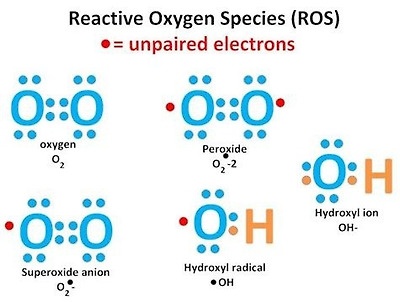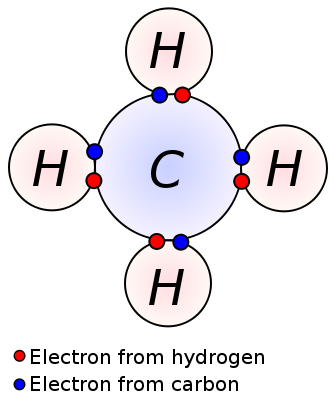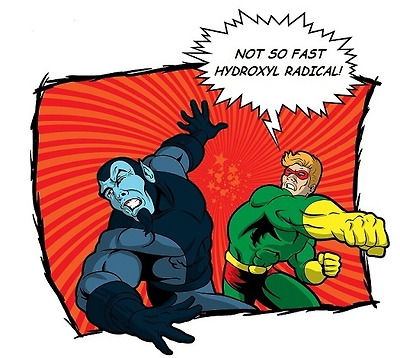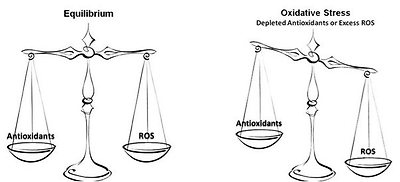What are the dangers of reactive oxygen species in the body?
Edwin Khoo, PhD student in Chemical Engineering at MIT
What exactly are ROS?
Reactive oxygen species (ROS) are reactive molecules containing oxygen in the body. Their reactive nature is essentially a byproduct of their unpaired electron(s).
Examples of ROS in the human body include peroxides, hydroxyl ions, hydroxyl radicals, and superoxide anions:
Reactive oxygen species (ROS) are reactive molecules containing oxygen in the body. Their reactive nature is essentially a byproduct of their unpaired electron(s).
Examples of ROS in the human body include peroxides, hydroxyl ions, hydroxyl radicals, and superoxide anions:

Why are these ROS so reactive?
These unpaired electrons give ROS molecules unstable configurations. Every molecule has a outer shell of
These unpaired electrons give ROS molecules unstable configurations. Every molecule has a outer shell of
electrons termed the valence shell. Molecules like to have their valence shell completely filled with electrons because this configuration grants stability. ROS do not have this configuration (as illustrated with the red electrons above). Molecules like to be stable. The body, just as it desires homeostasis, desires stability as well.
To achieve their desired stability, ROS molecules must share with or transfer an additional electron to another molecule. This can be achieved through covalent bond formation.
Covalent bond formation is not a transference, but rather a sharing of electrons between atoms.
To achieve their desired stability, ROS molecules must share with or transfer an additional electron to another molecule. This can be achieved through covalent bond formation.
Covalent bond formation is not a transference, but rather a sharing of electrons between atoms.

**NOTE: This electron sharing is not always equal. It depends on the relative electronegativities of the atoms involved in the transaction. For example, a hydrogen covalent bond formed between oxygen and hydrogen will favour oxygen due to it's high electronegativity. This will result in the electrons being pulled closer to the oxygen atom.
How do we deal with these ROS molecules?
So now that we understand why these ROS are reacting with various molecules within our body, let's take a look at how this is happening. We know that the ROS is going to react with some other molecule to achieve a full valence, and a stable configuration. Now the question simply becomes with who is that reaction occur and what are going to be the effects on the body? Once we understand this question we can understand when this will cause damage in the body and furthermore, as you will soon learn, why we are not always being harmed by the ROS in our body.
1) The first method, that which is most desirable, is achieved through the many antioxidant scavengers we have
patrolling around inside our bodies. These antioxidants come in the forms of vitamins, enzymes, and cofactors. There are specific antioxidants that we produce in order to deal with the various common ROS that we previously mentioned. These scavengers include enzymes such as catalase, superoxide dismutase, glutathione peroxidase, cofactors (factors that allow enzymes to fully function) such as glutathione, and vitamins such as vitamin A, C, and E.

These are the good guys, looking out for you and protecting the streets of your body from the emergence of new criminals and various other bad guys looking to scavenge an electron from the nearest willing molecule.
These enzymes, cofactors, and vitamins work to convert ROS into benign molecules such as water, and hydrogen peroxide. These molecules can be easily taken care of and will not cause any damage to your body.
2) The second method of dealing with these free radicals and peroxisomes is by allowing them to react with various cells and therefore tissues and organs. This does not require any work or energy on the part of our body but it comes at a price - the damage of the very cells that they are reacting with.
So where are these ROS coming from?
ROS can be produced either endogenously (from within your own body) or exogenously (from outside sources).
Endogenously, ROS are a natural byproduct of cell metabolism. However, they are also produced by other endogenous sources such as hypoxia (lack of oxygen), apoptosis (cell death), pro-inflammatory cytokines (like TNF-α), and oncogenic cancer intermediates (like Ras).
Exogenously, ROS can be formed through sources such as ionizing radiation (radiation that contains enough energy to remove electrons from atoms or molecules).
When do ROS become a problem?
As you have learned, ROS formed through normal levels of endogenous production such as regular cell metabolism should be adequately taken care of through our own bodies protective mechanisms. Through quenching these reactive molecules with various antioxidants including enzymes, cofactors, and vitamins, we therefore prevent the problems associated with the reckless oxidative damage these ROS are capable of when left unchecked.

The problem of damage exists when either a) ROS run out of check through an increase in number above that of your antioxidant levels or b) your antioxidants levels are below that of the ROS present. Of course this is not always true as some ROS will always manage to escape the grips of the antioxidants scavenging your body for them regardless of your antioxidant levels are high enough or not.
What exactly are these excessive ROS molecules doing to my body?
In general, the harmful effects of ROS come in the form of DNA damage, lipid preoccupation (oxidation of polyunsaturated fatty acids), protein amino acid oxidation, and inactivation of specific enzymes through oxidation of their cofactors.
These damages can be contributing factor to many general and specific problems and diseases such as Parkinson's, Alzheimer's, asthma, aging, cancer, Rheumatoid Arthritis, etc.

But wait, it's not all bad. Reactive oxygen species also have important roles in both cell signalling and homeostasis[1] such as recruiting platelets and providing a link to the immune system through the recruitment of leukocytes (white blood cells) via integrin (cell wall recruiting and signalling for cells to join the battle at the appropriate site) production in wound repair and other sites as the wound or other stimulus stimulates ROS production.
Of course all the research in this area on the effects of ROS are still incomplete, but on the bright side as research continues to fill in the gaps our understanding of ROS and their effects on our bodies will only become richer with time.
References:
- Devasagayam, TPA; Tilak JC; Boloor KK; Sane Ketaki S; Ghaskadbi Saroj S; Lele RD (October 2004). "Free Radicals and Antioxidants in Human Health: Current Status and Future Prospects". Journal of Association of Physicians of India (JAPI) 52: 796.
다음검색